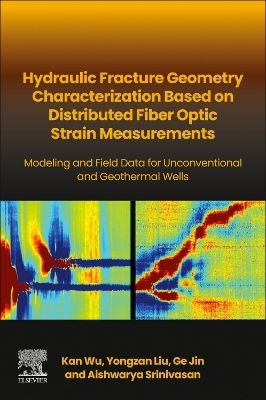
Hydraulic fracture geometry characterization based on distributed fiber optic strain measurements
Elsevier - Health Sciences Division (Verlag)
978-0-323-95362-7 (ISBN)
Dr Kan Wu is an associate Professor and Class of '75 DVG Career Development Professor in Harold Vance department of petroleum engineering at Texas A&M University. Her research interests include data interpretation and forward modeling of Distributed Fiber Optic Strain Sensing, hydraulic fracture modeling, monitoring, and optimization, subsurface monitoring of Carbon storage and Enhanced Geothermal Systems, Hybrid physics and data-driven modeling, multi-scale and multi-physics modeling. Wu has authored or co-authored more than 100 technical papers, which have been cited more than 5000 times (Source: Google Scholar). Wu is a founder and director of Advanced Geomechanics Fracture & Reservoir Application Consortium (AGFRAC). This consortium is at the forefront of advancing subsurface monitoring techniques using distributed fiber optic strain sensing, aiming to optimize injection and production processes in oil and gas reservoirs, CO2 storage, and geothermal development and address critical energy and environmental challenges. Wu was honored with the Karen E. Olson ’87 and Louis H. Turner Faculty Award for Excellence in Research in 2023. Additionally, in 2022, she received the Award for Best Application Paper sponsored by the International Geomechanics Symposium. She is serving as a Distinguished Lecturer for the Society of Petroleum Engineers (SPE) for the 2023-2024 term. Wu holds a Ph.D. degree in petroleum engineering from The University of Texas at Austin. Yongzan Liu is currently a research scientist at Schlumberger-Doll Research, located in Cambridge, Massachusetts, US. Before joining SLB, he was a postdoctoral research fellow in the Energy Geosciences Division at Lawrence Berkeley National Laboratory. He has been working on various research topics related to energy geomechanics, including coupled thermal-hydraulic-mechanical (THM) modeling of subsurface fractured reservoirs, hydraulic fracture monitoring and characterization, enhanced geothermal systems (EGS), system behaviors of gas hydrate accumulations, geological carbon storage, etc. He is currently interested in the integration of advanced numerical modeling and monitoring techniques to better understand the complex processes in subsurface reservoirs. He has authored/co-authored more than 30 technical papers. He holds a Ph.D. degree from Texas A&M University, an MS degree from the University of Alberta, and a BS degree from China University of Petroleum (East China), all in Petroleum Engineering. Dr. Ge Jin is an accomplished geophysicist and educator with a distinguished record of scholarship. He currently serves as an Assistant Professor of Geophysics and Co-director of the Reservoir Characterization Project at the Colorado School of Mines (Mines). With a focus on geomechanical applications, Dr. Jin also closely collaborates with the Advanced Geomechanics Fracture & Reservoir Application Consortium (AG-FRAC) at Texas A&M University in collaboration with Dr. Kan Wu. Dr. Jin has published more than 50 peer-reviewed papers in leading journals and has been granted 11 patents for his innovative research. His research interests lie in several areas, including Distributed Fiber-Optic Sensing (DFOS), machine learning, and seismic imaging and interpretation. Before his current academic job, he spent five years as a research geophysicist in the oil and gas industry, during which time he developed an in-depth understanding of the practical issues faced by the industry and filed numerous patent applications. His research in DFOS has led to several groundbreaking applications, which include reservoir distributed strain monitoring, DAS-based microseismic imaging, DFOS-based production logging, DFOS-based well integrity monitoring, borehole tube-wave analysis, and reservoir guided wave analysis. Dr. Jin obtained his Ph.D. in Geophysics from Columbia University in the City of New York, after completing his dual B.S. in Geophysics and Computer Science from Peking University. Aishwarya Srinivasan is a PhD student in the Harold Vance Department of Petroleum Engineering at Texas A&M University, College Station. She received her Master of Technology in chemical engineering from the Indian Institute of Technology, Guwahati, Assam, India and her Bachelor of Technology in Petroleum Engineering and Technology from Anna University, Chennai, India. Aishwarya’s research interests include fracture monitoring and diagnostics in the subsurface, geomechanics, fiber-optic sensing, and geothermal systems. Noteworthy achievements include being recognized as the "Outstanding Graduate Student" by SPE – Hydraulic Fracturing Technical Section in 2023. She secured second place in the PhD division of the SPE International Student Paper Contest 2023 and first place in the PhD division of the SPE GCNA & SWNA Regional Student Paper Contest 2023. A committed member of the SPE and the ARMA, Aishwarya is dedicated to advancing her field through research and active participation.
1. General Introduction
2. Fiber Optic Sensing Measurements
3. A Forward Model for Low-frequency Distributed Acoustic Sensing
4. Identification of Fracture Hits from Strain Rate Responses
5. An inversion Model for Hydraulic Fracture Geometry from Strain Data
6. Fracture Geometry Characterization from Low-frequency Distributed
7. Field Observation and Numerical Modeling of Distributed Strain Sensing
| Erscheinungsdatum | 21.08.2024 |
|---|---|
| Verlagsort | Philadelphia |
| Sprache | englisch |
| Maße | 152 x 229 mm |
| Gewicht | 450 g |
| Themenwelt | Technik ► Elektrotechnik / Energietechnik |
| Technik ► Umwelttechnik / Biotechnologie | |
| ISBN-10 | 0-323-95362-X / 032395362X |
| ISBN-13 | 978-0-323-95362-7 / 9780323953627 |
| Zustand | Neuware |
| Haben Sie eine Frage zum Produkt? |
aus dem Bereich


